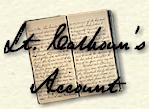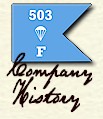
Fitzhugh Millican |
"After
I landed I saw a 'trooper hit a cement wall about four feet tall and ten feet
wide. I thought the crash had killed him. When I got to him and
cut him loose I saw it was Sgt. Petzelt, who'd led the second stick out. He
came to, jumped up and ran across the parade ground under sniper fire to the
assembly area.
When
I got to the assembly area I told Lt. Ball, who'd lead the third stick out
(evidently Ball jumpmastered all three sticks as many officers did in the 2nd
Battalion), that we needed to go after the missing men. Ball had
seen where the men landed and knew there was no hope, and gave me a direct
order to stay there.
"Our
first squad lost our mortar.*
So, unable to set it up,
with the squad's other members we searched the part of the long building that
we were in, with Pvt. John R. McKeown acting as our scout. We
found a large room full of boxes of beer, gin, and a soft drink. We were
afraid to drink it because it might be poisoned.
McKeown said "I'll drink
some, and if I'm not dead in five minutes we'll know it is safe."
He drank out of a bottle
and said "This is beer," then another bottle and said "this is gin," and
finally the third bottle and said "This tastes like 7-Up!"
He kept drinking and
didn't suffer any ill effects, so we all joined in. We took all we
wanted and then told others of our find. We helped one of the other
mortar squads set up their mortar at the end of the building. Had
the
Japs attacked that night, they would have had one helluva
battle. The E company mortar men were ready!"
|
|
 "1200
hour: The planes began to jockey around for new positions maneuvering
into two columns of single files, or trail formations. The left trail would
jump on A Field, the right trail on B Field. It seemed to me that time
passed rather quickly. T/Sgt Phillip Todd and I were kneeling in the
door behind two bundles of mortar ammunition. Then we
started passing over cruisers and destroyers. For some reason I thought
of the westerns I had seen in which Indians were attacking the surrounded
wagon train. We saw Bataan off to our left where a beachhead was
established yesterday. "1200
hour: The planes began to jockey around for new positions maneuvering
into two columns of single files, or trail formations. The left trail would
jump on A Field, the right trail on B Field. It seemed to me that time
passed rather quickly. T/Sgt Phillip Todd and I were kneeling in the
door behind two bundles of mortar ammunition. Then we
started passing over cruisers and destroyers. For some reason I thought
of the westerns I had seen in which Indians were attacking the surrounded
wagon train. We saw Bataan off to our left where a beachhead was
established yesterday.
1230
hour: Suddenly Todd said, �"There it is!" I saw bare, white cliffs
rising out of the sea, coming out from under our left wing. Then I could see
Topside and chutes strung all the way from the sea, up the cliffs and on "A"
and "B" Fields. We could hear small arms fire, both rifles and machine
guns. I first thought it was all fights on the ground then a bullet crashed
through the plane and I said "Oh! oh!" Todd looked down at me and gave a
big smile. He was standing in the door and I was kneeling with my head
stuck out between him and the right side of the door. He was going out
first on the first pass. I would gladly have traded places with him.
Then we were passing over the the small space called "B" Field. I
counted six seconds after we passed the "go" point, delayed about two more
seconds, shoved out the first bundle, delayed another second, slapped Todd on
the thigh and yelled "Go!" The stick hit perfectly. We were flying into
a twenty-five mile an hour wind which really blew the chutes back along our
line of flight.
Our plane circled and in about fifteen minutes came in on the next run.
This time I shoved the second bundle out and jumped S/Sgt Chris Johnson and
his stick. I jumped them a second early, but they all made it okay.
Johnson went over the edge not far and got back okay.
1300
hour: We made the third approach, and I was really glad. I was
tired of passing over this island and getting shot at. I was standing in the
door and slightly turned to the right looking back at my stick and gave the
command, "Stand in the door!" The next man jammed up so close to me that I
could not turn and square myself in the door. I delayed nine
seconds, yelled "Go!" and took my stick out. I jumped trying to turn
left and must have gone out head first, because I saw silk flashing by my
feet, but the chute opened without delay. I looked down and WOW!
Passing by me rapidly were bomb craters,
tree snags, and boulders. I seem to be standing still and all this was rushing
by me.
The wind was strong. I sure did want to get this landing over, and I did
in a hurry. From the low altitude jump we were not in the air long. I
went down into a large crater, slammed into its rocky side with my right side
splintering the stock of my Ml rifle. It knocked the breath out of me and I
thought broke some ribs. I did not breathe easy for days. My chute was
still full of air and trying to drag me up the side of the crater. Someone
from D Company got down in the crater and cut my risers off just above my
shoulder harness. I collected the stuff out of my kit bag after getting
out of the harness, snapped my musette bag on my harness and weakly crawled
out of the crater.
Although shaken I was very glad to be down on
the ground safely and without injury. Now to get to the assembly area. There
were stumps, tree stubs, rocks, and chunks of concrete with one inch
reinforcing bars exposed in places. Some of the steel bars protruding making
them deadly spears. There were some serious wounds and fatalities due to some
jumpers being speared on landing. The repeated bombings and shellings
Corregidor had taken in '41 and '42, and in past weeks had wrecked the surface
and left a heavy dust cover on everything. There was intermittent firing and
some men were getting hit on the field. I got Richard Peterson out of his
harness. We assembled at the assembly area.
In my platoon acting
Sgt. Wright, of the 2nd squad, Pfc Roland Reynolds of the 3rd squad, and Pfc
Phillip Smith of 2nd squad, had been injured on the jump. S/Sgt Charles
McCurry, Pfc Bill McDonald, Pfc Ralph Iverson, Pfc Marion Boone, Pfc Paul
Narrow, Pfc Theodore
Yocum,
and an Army Signal
Corps photographer were missing along with jumpmaster, 1st Sgt Albert Baldwin.
They were in plane 22, F Co.'s first plane.
For reasons I do not know, Bill Bailey led the
1st stick out with Henry Poisant right behind. The second pass, the second
stick was jumpmastered by (unknown). Baldwin was set to jumpmaster the 3rd,
but on the second pass the plane's left engine had been hit and it was unable
to make this third pass, so
they did
not jump. The plane returned with the third stick aboard."
|





![]()




![]()
![]()


















